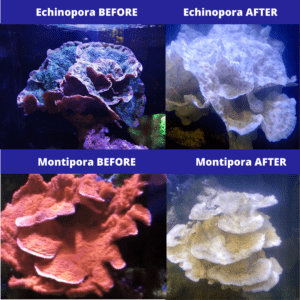Bleaching : a tragic incident in Planktovie’s tank
Knowing the right behaviour to adopt in case of bleaching in your aquarium
An aquarist’s job is to recreate the basic environment as identical as possible to that of the inhabitants of his aquarium, respecting and checking all the parameters regularly. The aim is to keep healthy aquatic animals in captivity.
During the summer season, the aquarist’s attention must be heightened due to rising temperatures, which can increase the temperature of the aquarium, potentially harming the inhabitants.
In the Planktovie offices, we installed a 260-litre marine aquarium in September 2019, including a 40-litre settling tank. With two aquarium enthusiasts in the company, including a scientist who worked for several years on certain corals (e.g. Fungia scutaria sp., Palythoa clavata sp.), our aquarium has been a haven of peace and happiness since its creation, with about ten fish, invertebrates, and a dozen corals. We check the parameters (pH, KH, Mg, Ca, salinity), do the aquarium tests and change 25% of the water once a week. We have also created an automatic system to regulate the parameters, thanks to a peristaltic pump that adds adequate additives (Magnesium, Calcium and Sodium Bicarbonate) when necessary.
Last Sunday, the Planktovie aquarium experienced a drama, which we would like to share with you.
History of the events :
- Friday, July 10th, we leave the offices after having carried out the weekly manipulations, leaving the tank and its inhabitants in good health, in water at a temperature of 27°C.
- On Sunday, July 12, we come to the company to ensure the maintenance of our research protocols, in particular our microalgae (dinoflagellates).
- 10:30 am: Time of damage assessment. Our Echinopora sp. Montipora sp. Euphylia sp. and Xenia sp. bleached, a fish (Anthias) died, the water was cloudy and a bad smell was felt in the room.
First reflex, check the water temperature. Temperature displayed: 27°C. However, as I put my hand in the water, it seemed much warmer. The first reflex was to tell oneself that the thermometer was no longer working properly, so a second thermometer was placed in the water to find out the true temperature.
Second check, temperature displayed: 35°C.
What could have happened for the water to rise by 8 degrees in one day, knowing that the office is air-conditioned with a temperature set at 25°C?
After examination, we realized that the thermometer probe placed in the settling tank had come loose from its base. This thermometer probe is connected to the aquarium and activates a heating resistor if the temperature drops below 27°C. The probe being outside the aquarium, it picked up the temperature in the office, which was regulated at 25°C. This activated the heating resistor, which must have heated up the water for a good part of the weekend.
We have chosen to write this week’s news about what happened with our aquarium, not to attract the wrath of aquarists, but to share a tragic experience reminding us all, whether beginners or even experts, that vigilance is essential when holding living beings under our responsibility, and that we must always be able to anticipate the slightest problem. Even after years of experience, we make mistakes and we learn. We must assume the lack of vigilance, know the right behaviour to adopt in a crisis, and share experiences so that they are not repeated.
Knowing that corals begin to bleach when the water reaches 31°C, it is obvious that at 35°C the aquarium was very far from the haven of peace and happiness it used to be. Because we must learn from our mistakes and share them, here is what we can learn from this tragic event:
When maintaining the aquarium, make sure that all installations are in good condition, well placed, and in working order. In our case, it would have been necessary to SECURE the temperature sensor so that it would not come off its base.
If this type of event (bleaching) occurs, you must react quickly or the entire aquarium will be lost. Here are the actions to be taken, which we have directly implemented following the discovery:
- Change 50% of the water,
- Remove as much decaying organic matter as possible from the water (as it decomposes into ammonia, which is toxic to zooplankton, and then nitrite, which is toxic to fish, corals and invertebrates),
- Check ammonia, nitrite and pH daily.
- If the ammonia level remains high 2 days later, change 50% of the water again,
- Add activated carbon (It traps pollutants and toxins in the aquarium that occur as a result of the death of certain organisms),
- Switch off the LED lamps and then switch them on again after at least 24 hours of inactivity, with very low intensity (10%). Increase the intensity gradually to reach 100% after 7-8 days,
- Continue to feed the inhabitants regularly without overdosing to avoid increasing the organic overload.
We share with a twinge in our heart some before/after pictures of our bleached corals, hoping that this text will allow aquarists to increase their attention on their aquarium, especially during the summer period, where temperature variations can be frequent due to the high heat.
Check your equipment, check the behaviour of your animals, check that your thermometer is working. Do not hesitate to add a thermometer in case the first one is defective. Error is human, but humans must learn when the life of others is in their hands.
Today we have learned a new lesson that we will not soon forget.


